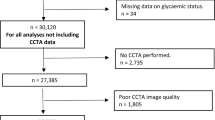Abstract
From a group of 251 high-risk patients less than 65 years of age, 84 with angiographic or vascular laboratory proven peripheral arterial occlusive disease were evaluated In detail. The following risk factors were identified: smoking in 91% with an average of 35 ± 18 pack/years; treated or untreated hypertension In 40%; hyperlipidemia In 49%; obesity with a body weight > 120% of ideal in 18%; diabetes In 9%; family history of premature vascular disease in 70%; and hyperuricemia in 13%. Based on these results, we have introduced a practical approach for investigating and managing risk factors that can be administered by paramedical personnel, utilizing a questionnaire given to patients and standard blood tests to identify important risk factors. The results of the completed questionnaires and blood test are entered on a microcomputer. A program written using d-Base III stores the data, identifies the risk factors and grades their severity. We have designed an information booklet that highlights the individual patient’s risk factors and suggests alternatives for management based on the sources of medical and community help available in our area.
Similar content being viewed by others
References
KANNEL WB, SCHATZKIN A. Risk factor analysis.Prog CardiovascDis 1983;26: 309–332.
Lipid Research Clinics Program. The Lipid Research Clinics coronary primary prevention trial results. 1. Reduction in incidence of coronary heart disease.JAMA 1984;251: 351–364.
KANNEL WB. Update on the role of cigarette smoking in coronary artery disease.Am Hearty 1981;101: 319–328.
Hypertension Detection and Follow-up Cooperative Group. Five-year findings of the hypertension detection and follow-up program. I. Reduction in mortality of persons with high blood pressure, including mild hypertension.JAMA 1979;242: 2562–71.
Hypertension Detection and Follow-up Program Cooperative Group. Mortality findings for stepped-care and referred-care participants in the hypertension detection and follow-up program, stratified by other risk factors.Preven Med 1985;14:312–35.
Study Group on TIA Criteria and Detection: Questionnaire for detection of TIA. In Sahs AL, Hartman EC, Eds. Fundamentals of stroke care, D.H.E.W. Publication #IIRA (76-14016) 1976: 41-17.
JOHNSTON KW, HAYNES RB, DOUVILLE Y, LALLY ME, BROWN PM, Cobbold RS. Accuracy of carotid Doppler peak frequency analysis: results determined by receiver operating characteristic curves and likelihood ratios.J Vase Surg 1985;2: 515–23.
HEYDEN S, BARTEL AG, TABESH E, CASSEL JC, TYROLER HA, CORNONI JC, HAMES CG. Angina pectoris and the Rose questionnaire.Arch Intern Med 1971;128:961–4.
New weight standards for men and women.Statistical Bulletin 1959;40: 1-4.
HAMMOND EC, GARFINKEL L. Coronary heart disease, stroke, and aortic aneurysm. Factors in etiology.Arch Env Health 1969;19: 167–82.
FIELDING JE. Smoking: health effects and control (1).N Engl J Med 1985;313:491–8.
Fielding JE. Smoking: health effects and control (2).N Engl J Med 1985;313: 555–61.
WILHELMSSON C, VEDIN JA, ELMFELDT D, TIBBLIN G, WILHELMSSON L. Smoking and myocardial infarction.Lancet 1975;1:415–20.
KING RB, MYERS KA, SCOTT DF, DEVINE TJ. Aorto-iliac reconstructions’ for intermittent claudication.Br J Surg 1982;69: 169–72.
GRAHAM JC, CAMERON AE, ISMAIL HI, HAMILTON WA, LAW YF, ROBERTS VC, COTTON LT. Axillofemoral and femorofemoral grafts: a 6-year experience with emphasis on the relationship of preoperative flow measurement to graft survival.Br J Surg 1983;70: 326–31.
CAMPEAU L, ENJALBERT M, LESPERANCE J, BOURASSA MG, KWITEROVICH P Jr, WACHOLDER S, SNIDERMAN A. The relation of risk factors to the development of atherosclerosis in saphenous-vein bypass grafts and the progression of disease in the native circulations. A study 10 years after aortocoronary bypass surgery.N Engl J Med 1984;311: 1329–32.
Memorandum from a WHO/1SN meeting. Guidelines for the treatment of mild hypertension.Hypertension 1983;5:394–7.
GORDON T, KANNEL WB, CASTELLI WP, et al. Lipoproteins, cardiovascular disease and death: The Framingham study.Arch Intern Med 1981;141:1128–1131.
CASTELLI GT, HJORTLAND MC. Prediction of coronary heart disease by high-density and other lipoproteins: An historical perspective, in Rifkind B, Levy R, eds. Hyperlipidemia-diagnosis and therapy. New York: Grune and Stratton, 1977: 71–78.
STREJA D, STEINER G, KWITEROVICH PO Jr. Plasma high-density lipoproteins and ischemic heart disease: studies in a large kindred with familial hypercholesterolemia.Ann Intern Med 1978;89: 871–80.
KANNEL WB, CASTELLI WP, GORDON T. Cholesterol in the prediction of atherosclerotic disease: New perspectives based on the Framingham Study.Ann Intern Med 1979; 90: 85–91.
NIH Consensus Development Conference Summary. Treatment of hypertriglyceridemia.Arteriosclerosis 1984;4:296–301.
ASHLEY FW Jr, KANNEL WB. Relation of weight change to changes in atherogenic traits. The Framingham study.J Chronic Dis 1974; 103–114.
KANNEL WB, MCGEE DL. Diabetes and cardiovascular disease: The Framingham study.JAMA 1979;241: 2035–2038,
JARRETT RJ, KEEN H. Diabetes and atherosclerosis, in KEEN H, JARRETT J, eds. Complications of diabetes. Chicago: Year Book, 1975:179–204.
SNOWDEN CB, McNAMARA PM, GARRISON RJ, et al. Predicting CHD in siblings — Multivariate assessment. The Framingham study.Am J Epidemiol 1982; 7/5:217–222.
REUNANEN A, TAKKUNEN H, KNEKT P, AROMAA A. Hyperuricemia as a risk factor for cardiovascular mortality.Acta Med Scand 1982;668:49–59.
KOVANEN Pt. Regulation of plasma cholesterol by hepatic lowdensity lipoprotein receptors.Am Heart J 1987;113:464–9.
McGILL HC Jr, STERN MP. Sex and atherosclerosis.Atherosclerosis Rev 1979;4: 157–242.
PAFFENBARGER RS. Physical activity and fatal heart attack: Protection or selection? in AMSTERDAM EA, WILMORE JH, DEMARIA AN, eds. Exercise in Cardiovascular Health and Disease. New York: Yorke Medical Books 1977: 35–49.
Build Study. Society of Actuaries and Association of Life Insurance Medical Directors of America, 1979.
Author information
Authors and Affiliations
About this article
Cite this article
Johnston, K.W., Rae, M., Steiner, G. et al. An atherosclerosis risk factor assessment program for patients with peripheral arterial occlusive disease. Annals of Vascular Surgery 2, 101–107 (1988). https://doi.org/10.1007/BF03187557
Issue Date:
DOI: https://doi.org/10.1007/BF03187557




